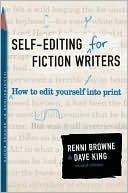More on this book
Community
Kindle Notes & Highlights
by
Renni Browne
Read between
January 16 - March 8, 2022
To write exposition at length—describing your characters’ pasts or events that happened before the story began or any information your readers might need to understand your plot—is to engage your readers’ intellects. What you want to do is to engage their emotions.
Narrative summary has its uses, the main one being to vary the rhythm and texture of your writing. Scenes are immediate and engaging, but scene after scene without a break can become relentless and exhausting, especially if you tend to write brief, intense scenes. Every once in a while you will want to slow things down to give your readers a chance to catch their breath, and narrative summary can be a good way to do this.
But telling your readers about your characters’ emotions is not the best way to get your readers involved. Far better to show why your characters feel the way they do.
You don’t want to give your readers information. You want to give them experiences.
So when you come across an explanation of a character’s emotion, simply cut the explanation. If the emotion is still shown, then the explanation wasn’t needed. If the emotion isn’t shown, rewrite the passage so that it is.
Allowing your characters’ emotions to steep into your descriptions also lets you use description more freely. When your descriptions simply convey information to your readers, they interrupt the story and slow the pace down. To avoid this, many writers pare description down to a bare minimum, often leaving their writing sterile and their pace overly uniform. When description also conveys a character’s personality or mood, you can use it to vary your pace or add texture without interrupting the flow. The description itself advances the story.
Proportion problems like this one probably arise from the same lack of confidence that leads beginning writers to describe emotions they’ve already shown.
No one outside of hack fiction has ever been able to grimace or smile or chuckle a sentence.
They jump out at the reader, make the reader aware, if only for a second, of the mechanics of writing. They draw attention to your technique, and a technique that distracts the reader is never a good idea. You want your readers to pay attention to your dialogue, not the means by which you get it to them.
But the very best thing you can do for good dialogue is never, ever to explain it.
When you try to accomplish the same effect twice, the weaker attempt is likely to undermine the power of the stronger one. Inspired by a very gifted novelist-client who is also a gifted writing instructor, we often write a formula in the margin of manuscripts: 1 + 1 = ½.
If each element of your story accomplishes one thing and one thing only, then your story will subtly, almost subliminally, feel artificial. When everything seems to be happening at once, then it will feel like real life.
How many -ing and as phrases do you write? It may be time to get out the highlighter and mark them all. Remember, the only ones that count are the ones that place a bit of action in a subordinate clause.


